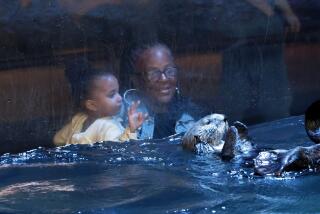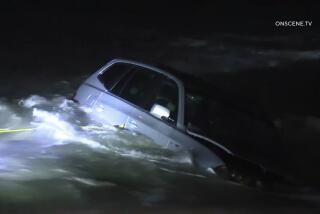Special Breed of Lifeguard
OXNARD — It was crunch time Saturday morning and young Monty knew it. The water rescue test was just a few months away and his job was to prove, during a pretest run-through, that he should be allowed to take the test, that he was lifeguard material to the bone. Unembarrassed, Monty was drooling.
His coach stood with him on the shore, patting him on the back and whispering words of encouragement: “That’s it, Monty. Want to do it, Monty? Ready to do it?”
In a flash, coach Peggy Lange gave the signal and Monty bounded into the ocean, his powerful doggy paddle propelling him elegantly toward the float he was to bring back to shore. He grabbed the floating object effortlessly and raced it to Lange.
Another challenge successfully met, Montana the 7-month-old Newfoundland puppy was headed for the big league of official Water Dog certification in September. Back on the sand, Monty, who already weighs 140 pounds, wagged his furry black tail with glee.
Using Channel Islands Harbor as a training ground, a handful of Newfoundland dog owners from the Southern California Newfoundland Club gather several times a year--as often as once a week before a test--to teach their animals what mostly comes naturally to them: water rescue.
The beaches in Los Angeles and Orange counties wouldn’t grant the permits needed for training the dogs in the ocean, so the club turned to Ventura County.
Dogs who demonstrate mastery in the junior division test are granted the title Water Dog; those who pass the senior division are called Water Rescue Dogs. Both tests of six skills each are sanctioned by the Newfoundland Club of America.
Practice drills are run over and over for the regular group of about a dozen dogs: bringing a life ring to a swimmer calling for help, swimming a line out to stranded boaters and then towing the boat to shore, jumping from a boat to retrieve a dropped oar, picking a swimmer in distress from those not in need of aid and towing the distressed swimmer to shore, and many others. Between the in-water days, the owners work with their dogs on land.
With webbed paws, muscular bodies that can weigh more than 175 pounds and a slobbery sweetness, Newfoundlands were traditionally as useful to farmers and hunters for carting and carrying as they were to fishing crews in Newfoundland and Labrador, Canada, for retrieving waterlogged nets and overboard sailors.
Throughout the upper United States and Canada, the dogs continue to be used for mountain and icy water rescues because their thick double coats protect them from the cold.
Newfies, as their owners call them, are now mostly bred to be beautiful, children-loving family pets. Nana, the dog in the children’s classic “Peter Pan,” was a Landseer, or black and white, Newfoundland. They were listed as the dog to own in the 1980s spoof “The Preppie Handbook.”
But more and more owners are determined to bring their bearlike dogs back to their roots.
“Hopefully, they won’t ever find a person in real trouble,” said Alex Rose, who along with husband, Rob Meadows, carts their two Landseers from West Hollywood to Ventura County each week for training. “But if something happens to somebody, they will have the ability to save them.”
Some of the animals don’t need much coaxing. Lange said one of her dogs, before it was trained, bounded into the ocean to “rescue” a child who was having a fine time in the water. The dog, she said, mistook the child’s laughing, yelling and flapping arms as signs of trouble.
Even puppies can be bad water playmates, nudging a perfectly capable swimmer away from the center of the pool and back to the safety of the side.
To make the most of the Newfie’s instincts, however, takes a lot of work.
From the moment the cars leave the freeway, the dogs can smell their beloved ocean water. Getting the animals to wait their turn on the beach and resist the temptation to swim every which way once they get in the water is as much of a challenge for many of the owners as teaching the rescue skills.
Rose’s dog Phinn, an 87-pound puppy, was more than happy Saturday to put a towline in his mouth and splash about. Getting him to swim the line out to her husband, however, was another story.
Rose tried pushing Phinn out while Meadows called to the happily frolicking dog. “Come on, Phinny!” he yelled to no avail. “Come to me!”
Exasperated with a trick that usually works, Rose attached Phinn to an extra-long leash and gave the end to Meadows. This time when he called the dog, Meadows gently reeled the animal in.
Then there was the retrieve-the-boat test. Phinn eagerly swam to the bobbing float, pulled it most of the way back to shore, but then stopped to walk around it for a while in the shallow water, shaking off a virtual flood as he took a winding path back to the eagerly awaiting Rose.
Rose, delighted when Phinn finally brought her the toy, was effusive with her praise.
“You can have a perfect Water Dog and then the day of the test, the dog has an off day,” said breeder Janice Anderson, Montana’s co-owner. “You’re nervous, and I think the dog picks that up and gets thrown off. They look at you like, ‘You want me to do what?’ and then just stand there on the shore.”
Some tests are particularly difficult. Dogs eventually learn to tow a boat parallel to shore when their instinct is to tow it in; they learn to swim with their handler to a given point, although their instinct is to herd the human back to the sand.
Newfie owners say they train their dogs because they enjoy doing it. But after paying as much as $3,000 for their animals, Newfie “parents” are notoriously obsessed with their pets. One member of the San Diego chapter even took his two Newfies to the Canadian province that gave them their name so the dogs could “get in touch with their roots.”
In the plus column, these lifeguard hopefuls don’t need sunscreen. No chance they’ll be babe-watching when they should be supervising swimmers. They don’t wear intimidating shades or neon nose cream. On the other hand, they tend to drool. And when they get out of the water, anyone near them gets a shower while they shake off.
“It’s worth it,” Lange said. “They’re just wonderful.”
More to Read
Sign up for Essential California
The most important California stories and recommendations in your inbox every morning.
You may occasionally receive promotional content from the Los Angeles Times.










